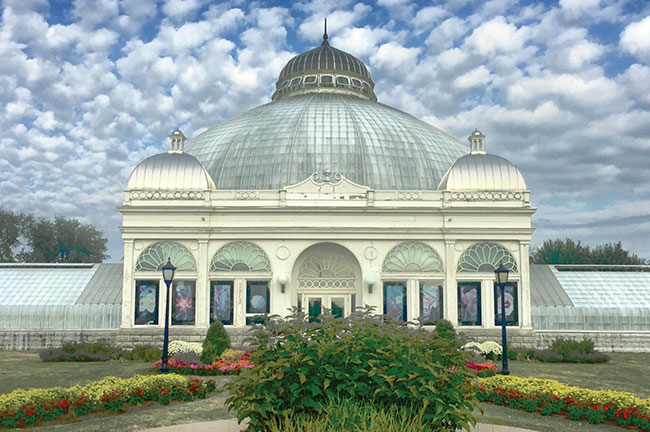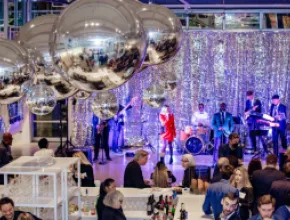In the late 19th and early 20th centuries, Buffalo, N.Y., experienced a revolution in American architecture. The towers, civic buildings and other structures created by Henry Hobson (H.H.) Richardson, Louis Sullivan, Daniel Burnham, Frank Lloyd Wright and other visionaries defined a dynamic new national aesthetic for U.S. cities.
The groundbreaking integration of parks by landscape architects Frederick Law Olmsted and Calvert Vaux also earned Buffalo global acclaim, and became a national model for urban landscape design.
No less artful were the collaborative talents of geology, water and time, creating the mighty nearby Niagara Falls. Straddling the U.S.-Canadian border and sharing New York and Ontario addresses, the site of one of the world’s largest cascades is a magnificent stage for meetings.
These elements combined make the Buffalo-Niagara region a unique, historical landscape for meetings and events.
Buffalo Venues With Exceptional Architecture
The Queen City of the Great Lakes literally sings with magnificent buildings.
Principally rendered by Finnish father-and-son architects Eliel and Eero Saarinen, Kleinhans Music Hall is globally renowned for its extraordinary acoustics. Built to resemble the body of a string instrument, this National Historic Landmark has been the Buffalo Philharmonic Orchestra’s home since opening in 1940. Versatile rentals include the 2,400-seat Main Auditorium and 1,000-capacity Mary Seaton Room.
Opened in 1926, Shea’s Performing Arts Center is reportedly the only Tiffany-designed theater still in existence. Buffalo’s home for touring Broadway shows, the landmark’s original “Wonder Theater,” now the 3,019-seat Shea’s Buffalo, is among several flexible event venues. Architectural tours are another group draw.
Babeville Buffalo is a 19th century Gothic Revival-style church located in the Theater District that was saved from demolition by Buffalo-born folk singer and songwriter Ani DiFranco. Rentals include the 1,200-capacity Asbury Hall, featuring 45-foot ceilings, and the subterranean 150-capacity Ninth Ward.

Babeville Buffalo Asbury Hall, Credit: Drew Brown
Musical greats Dizzy Gillespie, Billie Holliday, Miles Davis and John Coltrane once played at the Colored Musicians Club. Dating back a century, this sole surviving African-American club hosts live music and includes a tour-capable museum dedicated to the history of Buffalo jazz.
From 1927 to 1949, Buffalo was second behind Chicago for Frank Lloyd Wright-designed structures. Of these, Wright considered his 1905 Prairie-style Martin House Complex a “well-nigh perfect composition.” This summer, the nearly 25-year, $50 million restoration of the five-building estate will be complete. Tours and meeting space rental are now available, including at the Eleanor and Wilson Greatbatch Pavilion.
Hotel Lafayette was designed principally by America’s first woman architect, Louise Bethune, in 1904. Updated in 2012, the French Renaissance-style landmark is now the 57-room Hotel @ the Lafayette, offering 13,500 square feet of flexible meeting and ballroom space.
Daniel Burnham’s 1896 Ellicott Square Building was once the world’s largest office building. Today, groups can dine at catered events under the spectacular glass skylight of this Italian Renaissance-style landmark’s atrium.
H.H. Richardson, one of “The Recognized Trinity of American Architecture,” created the 1880 Buffalo State Asylum for the Insane in his signature Romanesque style, featuring two tall towers flanked by brick pavilions. Following a nearly $100 million transformation, this national landmark today is Hotel Henry, an 88-room hotel with a 20,000-plus-square-foot conference center. Olmsted and Vaux landscaped the grounds.
Olmsted also co-designed the 1900 Buffalo and Erie County Botanical Gardens.

Buffalo and Erie County Botanical Gardens, Credit: Ed Healy
Inspired by London’s legendary Crystal Palace, this national landmark site attracts over 100,000 people annually. Rental spaces include the tri-domed glass conservatory designed by famed Buffalo-born greenhouse architects Lord & Burnham.
Historical Highlights in Niagara Falls, N.Y.
Olmsted’s coast-to-coast influence included nearby Niagara Falls. While working on Buffalo’s parks in the 1860s, he advocated for the scenic preservation of the famed cascades, then threatened by tourism over-development.
Olmsted collaboratively helped to establish the Niagara Reservation—the first park of its kind created by a state government—which he and Vaux then designed. With the American Falls as its centerpiece, the nation’s oldest park, Niagara Falls State Park, opened in 1885.
This 400-acre state treasure is packed with planner-ready activities, tours and event venues. Highlights include hiking trails leading to the Schoellkopf Power Station (1904) ruins, the Maid of the Mist boat tour and the thrilling descent into the Cave of the Winds that puts visitors within feet of Bridal Veil Falls.

Niagara Falls State Park, Credit: NYS Office Office of Parks
Old Fort Niagara is North America’s oldest continuously occupied military site. Changing hands several times among the French, British and Americans from 1679 onward, the fort has been in U.S. command since 1815. Amid original 18th century buildings and fortifications, groups can access year-round programming, including tours, re-enactments and special events.
Located inside the former 1863 U.S. Custom House, the Niagara Falls Underground Railroad Heritage Center is an experiential museum that reveals authentic stories of Underground Railroad freedom seekers and abolitionists in the area.
Lockport Locks & Erie Canal Cruises showcases unique features of the legendary Erie Canal, including Lockport's Upside-Down Bridge and the Big Bridge, and the canal’s only set of double locks.
Recently completing a multimillion-dollar renovation, the Niagara Power Vista serves as the visitor center for the Niagara Power Project hydroelectric power plant. The venue features 50 interactive exhibits about hydroelectricity. Hands-on highlights include taking high-tech virtual ride across New York state on high-tension lines and operating a power grid during a storm. The observation deck perched 350 feet above the Niagara River Gorge is equally electrifying.
Natural Beauty in Niagara Falls, Ontario
The Canadian side of Niagara Falls is accessible from the U.S. via three bridges, including the walkable Rainbow Bridge and Whirlpool Bridge (which is only accessible for NEXUS members). This side has its own legacy of environmental stewardship.
Superior service defines the world-class Niagara Parks Commission, a self-funded governmental agency created in 1885 to maintain and preserve Niagara Falls and the Niagara River corridor.
Managing 4,250 acres of parks and amenities from Lake Erie to Lake Ontario, the commission is a one-stop shop for planning and attendance building.
Partner venue Table Rock Centre began a multimillion-dollar renovation in November 2018. Named for a massive rock slab jutting over the falls, the site’s historic event-capable Elements on the Falls restaurant is slated for a spring 2019 reopening as Table Rock House Restaurant.
Groups can also dine at storied Queen Victoria Place, constructed in 1904 as the former residence of the commissioners of Niagara Parks.
Buffalo-Niagara CVB Contact Information
Destination Niagara USA
716.282.8992
Niagara Falls Tourism (Canada)
905.356.6061
Niagara Parks Commission (Canada)
905.371.0252
Visit Buffalo Niagara
716.852.0511







